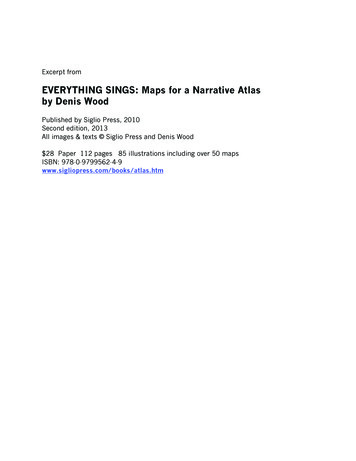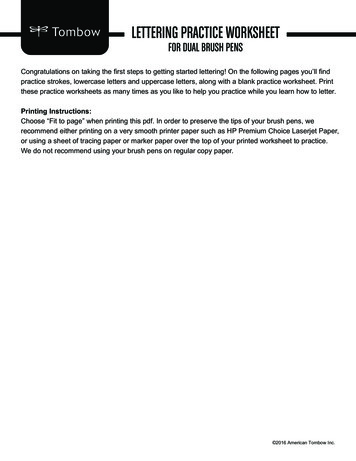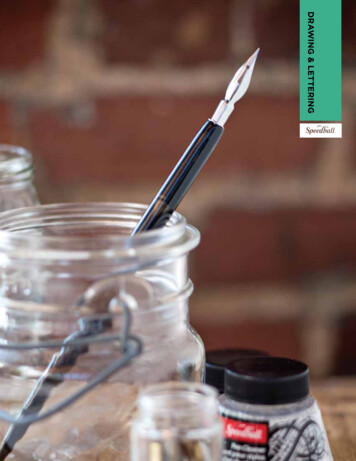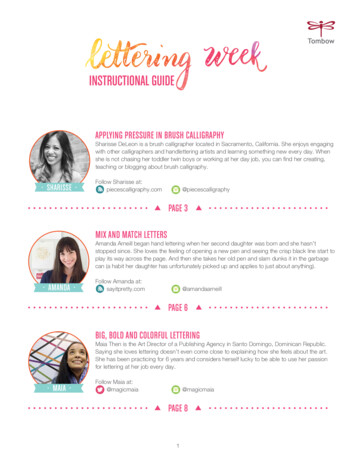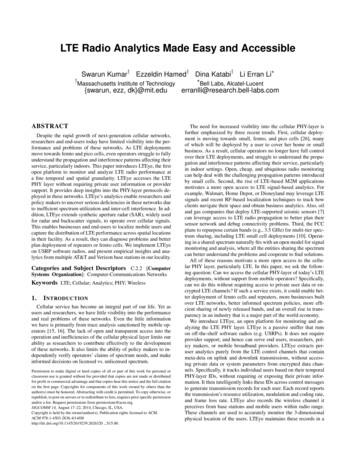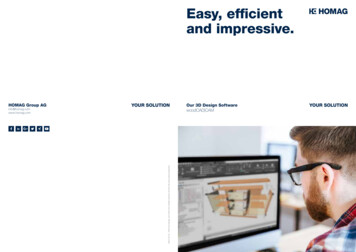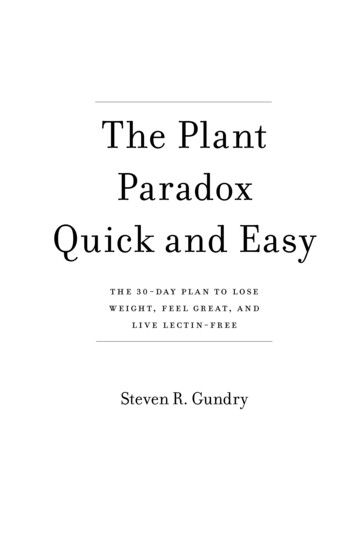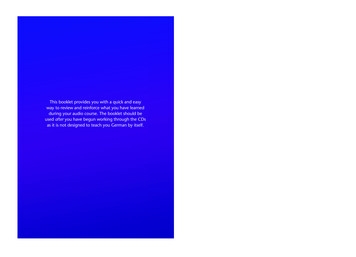
Transcription
EASY LETTERING FOR SINGS AND POSTERSa learning element for staff of consumer cooperativesinternational labour office, geneva MATCOM 1978-2001by Lars Josefson
MATCOMMaterial and techniques for cooperatives management trainingThe MATCOM Project was launched in 1978 by the International Labour Office, withthe financial support of Sweden. In its third phase (1984-1986) MATCOM is financedby Denmark, Finland and Norway.In collaboration with cooperative organizations and training institutes in all regions ofthe world, MATCOM designs and produces material for the training of managers ofcooperatives and assists in the preparation of adapted versions for use in variouscountries. MATCOM also provides support for improving the methodology ofcooperative training and for the training of trainers.Publications of the International Labour Office enjoy copyright under Protocol 2 of theUniversal Copyright Convention. For reproduction, adaptation or translation,application should be made to ILO Publications, International Labour Office, CH-1211Geneva 22, Switzerland. The International Labour Office welcomes such applications.Copyright International Labour Organization
CONTENTSA nice shop2Some practical advice4Introductory exercises5Quick lettering-the method8Numbers9Letters14Words17Signs and posters24
You enter a nice shop. The first things that catch yourattention are the attractive posters and price signshere and there in the shop. They function as "silentsalesmen", and they-are very effective. If they are well made,they give quick information to the customers, and theymay even "sell" the goods by themselves. We realizethat these posters and signs must be very important aidsfor the customers and for the shop personnel.The big posters that you see in co-operative shops aresometimes prepared by professional draftsmen, and thenprinted and distributed for use in all co-operative retail shops.But very often the signs and posters, especially the smaller ohesand those used for special displays, must be preparedby the shop staff. So someone in the shop must be able towrite nice block letters. If they are not nice, customerswill have a bad impression of the shop.
This booklet will help you to learn how to write nice block letters.It is easy to learn. Don't say you have no talent for it!Already after the first hour of practice you will see your progress.You will learn it! It is interesting and fun!
EQUIPMENT NEEDEDMarking pens with points about 1/4 inch.Colours: black, red and blue.To do the exercises in this booklet youneed tracing paper and some wrappingpaper or cardboard for practice.For the actual signs and posters you needwhite cardboard.ALWAYS USE A BASEA newspaper or an old sign will do nicely.REPLACE THE PEN CAPI MMEDIATELY AFTER USE!KEEP YOUR MATERIAL AND YOURWORKING PLACE CLEAN AND TIDY!
Place the marking pen betweenyour thumb and your index fingeHold the pen near the point.The angle between the markingpen and the writing surfaceshould be about 50'. As showni n the figure, you should writeusing the edge of the pen point.Keep your wrist onthe table!If the pen squeaks or the line blots, you are holdingthe pen too upright.To draw lines horizontally, turn the markingThe tip of the pen pointpen so that the tip is upwards (see figure).should always be kept toLean the pen softly to the right and draw.the left when you draw aline from top to bottom.To get good results,make wide strokes.
Place tracing paper on these pages and fill in the patterns. Draw as the arrows show.Use long, smooth strokes and keep the pressure steady.Practise until you get even, broad lines,You will print best with both arms on thevertically and horizontally. It is nottable, with the sign placed so that thei mportant if your pen does not wholly fillprinting is done about 20-25 centimetresthe pattern. Do not try to fix it afterwards.from the edge of the table. After a whileyou will see that you will get best resultswhen you are standing up.
KEEP THE TIP UPWARDS!Practise to join two differentli nes. Do not try to improvethe result by "touching up"afterwards.
We have developed a method which makes it easy for you to learnhow to draw numbers and letters quickly.The numbers 3, 5, 6 and 8 give you an idea of the method.The arrows show that they are all made in the same way.You should move your pen as the arrows show.I n this way you can write numbers and letters in an attractive stylewhich is easy to read.
Trace the numbers on this page!Place tracing paper over the numbers,draw each line only once. Even if yourpen point is not as wide as the number,Move your pen the way the arrows show!do not go back to fill it out.
The most common mistakes are shown below.Check the numbers you have drawn and make thenecessary corrections.
Use the same size for all thecommon price signs in the shop-otherwise the overall impressionmay be messy!Use large numbers. but alwayremember to leave a spacearound them.Keep the numberst ogether!Decimals can be underlined as shown above.
You can get a good effect if you printblack numbers on a yellow or orangebackground. Other designs are shown inthe following illustrations.First write the price in red or orange.The spacing between the numbersshould be a bit larger than usual.Then draw a wide black or blue line tothe left of each column or loop. You geta three-dimensional effect. Do not let thecolours cover each other. Once you liftyour pen, do not try to "touch up",it won't improve the result.Use the tip of the pen whenyou need shadow-lines onsmaller numbers.
A simple mark or symbol can"give life" to a sign and to thewhole display. Make largercopies of these examples. Tryyour own ideas.First write the price (13-15 cmhigh numbers) in red or orange.Then draw a black or blue linearound and inside each numberKeep a few millimetresbetween the colours. Note: thecontour line should always bein a darker colour.You can also draw the figures in yellow,orange, red or green, and then draw a heavyblack line in the middle.13
Draw letters the same way you drawnumbers. The arrows in the figuresshow you how to move the marker.Put tracing paper on top of the pages and draw each letter until youknow you can do it by yourself.
First practise the letter S as shown on the leftWhen your hand and eye are used to theshape of the letter, practise the example onthe right.
When you know how to write separate letters, it is time to practise thewriting of words and short sales messages.First--here are some helpful points.This is badly written. Too much space between the lettersmakes it hard to read the words.Again, varying spaces between letters have the samenegative effect.Always check your signs carefully. It is easyto make mistakes in spelling or word order.This is how it should look!Underline important sales words witha thick line in the same colour.
This does not look nice! The loops aretoo small in P and R; the middle line in Ei s too high up.Now the word is better balanced, as theline shows. It looks nicer and it is easierto read.Your words are easier to readif they are put on a straightli ne or are slanted upwards.If you write the letters too fast,they may be uneven, but you cani mprove the result if you put a lineunder the word.When you practise some lettercombinations you will see that you canmake the words easier to read if you makesome lines shorter, and other lines longer.
The text is a bit slanted.This "gives life" to the message.
How to make sales messagesand slogans look different andInteresting.Write slogans and "sales words" in the same waysas the numbers on pages 12-13.
ftmenup
THE PRICE CARD LAYOUT!If you have just a few linesof copy, keep the left marginstraight-the text will beeasier to read and easierto write.The bottom marginshould be somewhatwider than the space atthe top. This raises thesales message andmakes it easier to read.(This is also true forframing prints andphotographs.)The price does theselling, so let itdominate the poster.Print large, easy-toread numbers coveri ng 50% of the surface.DIRECTIONS:First make a little pencil sketch of your idea. It saves timeand builds confidence.Make it as simple as possible and make sure it is readable.Use one, two-but certainly no more than three colourson a poster.Dark letters on a light background are easy to read.The smaller the printing the darker should be the colour.Short, easily read messages sell best.Add simple drawings or clippings for interest.Advertising posters should be varied and be changedoften.
On the following pages you will findexamples of price signs which are "selling"and easy to read. Practise writing signs ofthis type. Use A4-size for your signs (it is thesize of this page).A simple, easy-to-read design,very good for a whole series ofprice signs.These price signs have both text and price. They can befastened with tape, put in special holders or hung upclose to the actual product. Inside the shop it is best touse signs which are higher than they are wide; they areeasier to read and do not block the goods as much aswider signs.
Now you know how to make signs and posters.Remember: practice makes perfect. From time to time,come back to this booklet and check up that youfollow the rules given here for quick and nice lettering.
Quick lettering-the method 8 Numbers 9 Letters 14 Words 17 Signs and posters 24. You enter a nice shop. The first things that catch your attention are the attractive posters and price signs here and there in the shop. They function as "silent salesmen", and they-are very effective. If they are well made, they give quick information to the customers, and they may even "sell" the goods by .
